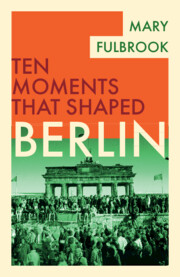Refine search
Actions for selected content:
86 results
Chapter 8 - Place, Environment, and Planetary Health
- from Section 2 - Foundation Knowledge of Lifestyle Medicine
-
-
- Book:
- Essential Lifestyle Medicine
- Published online:
- 01 May 2025
- Print publication:
- 15 May 2025, pp 67-72
-
- Chapter
- Export citation
Misplaced Priorities, Unnecessary Effects: Collective Suffering and Survival in Pandemic Philippines
-
- Journal:
- Asia-Pacific Journal / Volume 18 / Issue 15 / August 2020
- Published online by Cambridge University Press:
- 14 March 2025, e6
-
- Article
-
- You have access
- Open access
- Export citation

Berlin
-
- Published online:
- 13 February 2025
- Print publication:
- 30 January 2025
4 - Modern Times
-
- Book:
- Exhibitionist Japan
- Published online:
- 06 February 2025
- Print publication:
- 13 February 2025, pp 97-124
-
- Chapter
- Export citation
2 - From the Lorry Age to the Age of Hustle
-
- Book:
- Bus Station Hustle
- Published online:
- 09 February 2025
- Print publication:
- 13 February 2025, pp 32-54
-
- Chapter
-
- You have access
- Open access
- HTML
- Export citation
5 - World City
-
- Book:
- Berlin
- Published online:
- 13 February 2025
- Print publication:
- 30 January 2025, pp 80-108
-
- Chapter
- Export citation
Intergenerational trends in body size among Moscow’s young adults: socio-demographic influences of the 20th century
-
- Journal:
- Journal of Biosocial Science / Volume 57 / Issue 1 / January 2025
- Published online by Cambridge University Press:
- 08 January 2025, pp. 57-74
-
- Article
-
- You have access
- Open access
- HTML
- Export citation
3 - Oil and Authoritarian Modernisation During Interwar Period
-
- Book:
- Toiling for Oil
- Published online:
- 28 November 2024
- Print publication:
- 05 December 2024, pp 70-112
-
- Chapter
- Export citation
‘Princely seats’ and Thessalian hillforts: pre-urban Greece and the diffusion of urbanism in Early Iron Age Europe
-
- Article
-
- You have access
- Open access
- HTML
- Export citation
The Tang legacy on the Silk Road during the Uighur era: urbanisation in the eastern Tianshan region during the ninth to thirteenth centuries
-
- Journal:
- Journal of the Royal Asiatic Society / Volume 34 / Issue 2 / April 2024
- Published online by Cambridge University Press:
- 16 February 2024, pp. 377-398
- Print publication:
- April 2024
-
- Article
- Export citation
Chapter 7 - The Impacts of Urbanising the World’s Population on Emergencies, Incidents, Disasters, and Disease Outbreaks
- from Section 1 - The Nature and Impacts of Twenty-First-Century Healthcare Emergencies
-
-
- Book:
- Major Incidents, Pandemics and Mental Health
- Published online:
- 11 January 2024
- Print publication:
- 01 February 2024, pp 30-35
-
- Chapter
- Export citation
3 - New Cities in Africa and the Reimagination of Urban Planning
- from Part I - Understanding Sustainable Urban Planning in Africa
-
-
- Book:
- Reimagining Urban Planning in Africa
- Published online:
- 07 December 2023
- Print publication:
- 21 December 2023, pp 36-51
-
- Chapter
- Export citation
21 - On the Future of Urban Planning in Africa
- from Part III - Sustainable Urban Planning in Africa
-
-
- Book:
- Reimagining Urban Planning in Africa
- Published online:
- 07 December 2023
- Print publication:
- 21 December 2023, pp 390-397
-
- Chapter
- Export citation
4 - Informal Settlements and Pro-poor Urban Planning in African Cities
- from Part I - Understanding Sustainable Urban Planning in Africa
-
-
- Book:
- Reimagining Urban Planning in Africa
- Published online:
- 07 December 2023
- Print publication:
- 21 December 2023, pp 52-69
-
- Chapter
- Export citation
Chapter 13 - Byron’s Bear and Other Animals
-
-
- Book:
- The Cambridge Companion to Byron
- Published online:
- 02 November 2023
- Print publication:
- 16 November 2023, pp 209-227
-
- Chapter
- Export citation
7 - Urban Development and the Politics of Expropriation
-
- Book:
- Ethiopia’s ‘Developmental State’
- Published online:
- 21 September 2023
- Print publication:
- 05 October 2023, pp 186-209
-
- Chapter
-
- You have access
- Open access
- HTML
- Export citation
1 - Securing the Future: Family, Livelihoods, and Mobility
-
- Book:
- Relative Distance
- Published online:
- 22 June 2023
- Print publication:
- 06 July 2023, pp 30-54
-
- Chapter
- Export citation
Another emerging threat to birds: avian mortality estimates from roadside transparent noise barrier collisions in South Korea
-
- Journal:
- Bird Conservation International / Volume 33 / 2023
- Published online by Cambridge University Press:
- 13 March 2023, e50
-
- Article
-
- You have access
- Open access
- HTML
- Export citation
4 - From Taovia to Trustee
-
- Book:
- Gender, Property and Politics in the Pacific
- Published online:
- 19 January 2023
- Print publication:
- 26 January 2023, pp 129-165
-
- Chapter
- Export citation
3 - Why Are the Danes So Individualistic?
-
- Book:
- Our Long Walk to Economic Freedom
- Published online:
- 30 August 2022
- Print publication:
- 04 August 2022, pp 17-22
-
- Chapter
- Export citation
